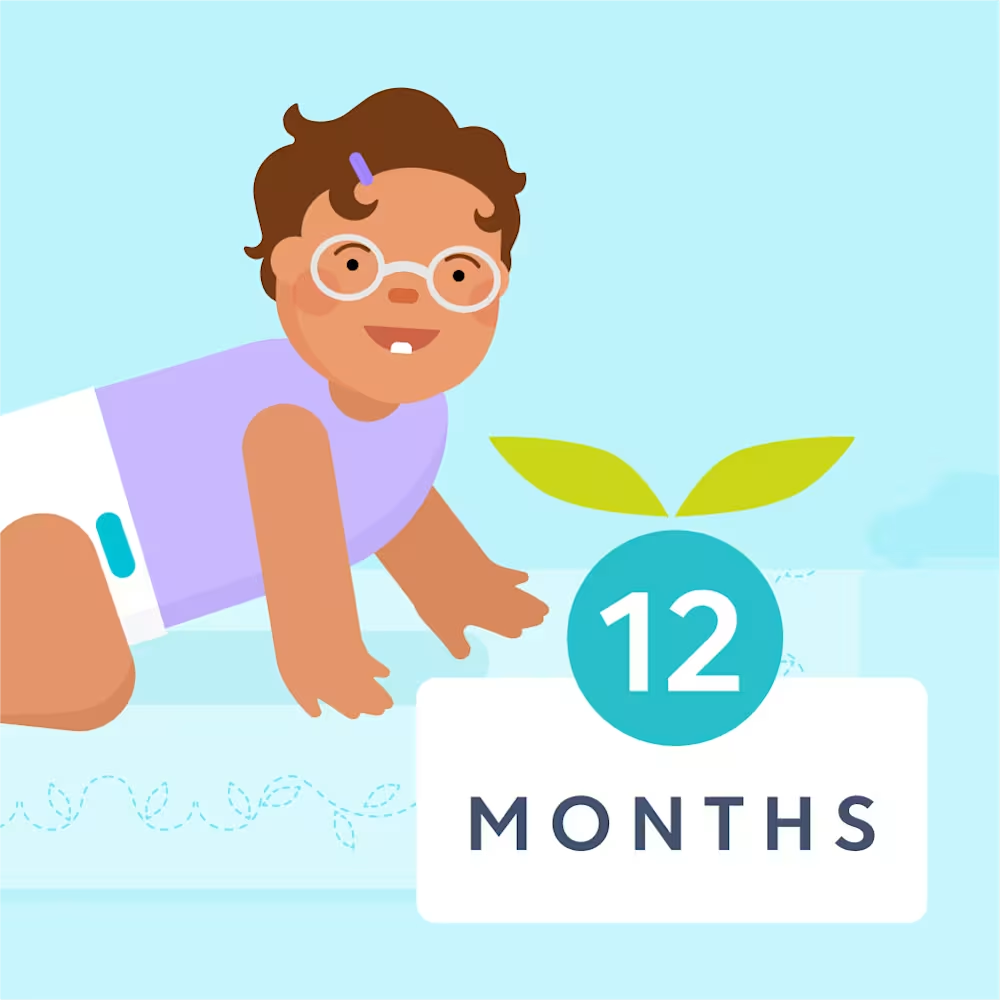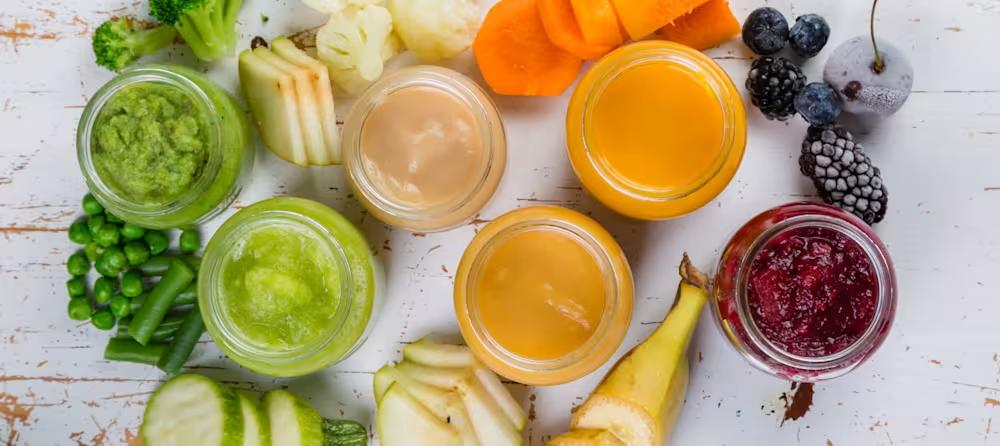Circling back on solids at 12 months
Updated Jan 12, 2026

As your baby approaches their first birthday, you may begin wondering what, if any, new foods they can enjoy. And the answer is — there are a few! Since feeding your baby is an ever-changing journey, we’ve put together everything you need to know about what foods to feed your child at 12 months as well as what to expect when it comes to feeding. Keep reading for information and a sample 12 month old feeding schedule.
What to expect when serving solids to a 12 month old
Around 12 months old, many parents notice their baby who once ate everything, no longer seems to eat as much as they used to. While it can cause concern that their baby isn’t eating enough, it is, in fact, a normal pattern at this age. As babies become toddlers, their growth rate slows down [], and the amount of food they need decreases. Additionally, their appetite may vary considerably from day to day.
Ideally, your baby’s main source of nutrition switches from breastmilk and/or formula to solid food at 1 year old. While you may continue to breastfeed as long as you wish, there isn’t a need for formula beyond 12 months. Instead, you could focus on serving three meals and two snacks a day [] in order to give your child the nutrition and energy they require.
Babies at this age should be eating finger foods cut up into small pieces and should be mostly self-feeding, although they may need a little help now and then. Aim to feed your 1 year old the same foods as the rest of the family, but use caution when serving heavily-processed foods as they may be high in salt, sugar, and/or saturated fat.
What foods can I introduce to my 12 month old?
At 12 months of age, toddlers can eat most foods as long as they are served in a safe way (check our resource for more info). Typically, this means cutting up into bite-size pieces. Continue to introduce new foods and aim to get as much variety in the diet as possible. You may also choose to introduce foods that were off-limits before one year such as honey or cow’s milk or cow’s milk alternative as a beverage.
One key to feeding at this age, when some kids become more selective eaters, is to continuously expose kids to the foods you want them to eat and model eating those foods yourself. As the parent or caregiver, you are responsible for what is served, where it will be eaten, and when the meal or snack will occur. The child is responsible for deciding if they will eat and how much. Avoid pressuring your child to eat and trust they have the ability to honor their hunger and fullness cues.
Throughout the course of a week or so, your toddler’s diet should include a variety of foods from the groups below. If you feel your child is only eating a small number of foods, reach out to your pediatrician or work with a pediatric dietitian who can help you fill any nutritional gaps and widen the variety in your child’s diet.
Fruits and vegetables
Fruits and vegetables provide your growing child with many important vitamins and minerals. They are also great sources of fiber and water which can help ward off constipation and other digestive issues toddlers sometimes face. Learning to like fruits and vegetables can be tough for some kids, so don’t be afraid to cook them with olive oil or butter, salt, or other seasonings and spices to make them taste good.
Dairy foods or dairy-alternatives
Dairy foods such as milk, yogurt, and cheese are usually pretty likable to toddlers. [] recommends 16 - 24 ounces of milk a day for children who are 12 - 24 months of age. These foods provide important nutrients such as protein, fat, calcium, potassium, iodine, and vitamin D. They are a great way to round out a meal and are important for supporting overall growth and bone health. If you are choosing a dairy alternative, be sure to read the nutrition label and choose products that offer similar nutrients.
Protein foods
Protein fuels growth and development [] as well as supports the immune system. Foods containing protein help keep kids full throughout the day. Many animal foods, such as meat, fish, eggs, and dairy products, are excellent sources of protein. However, sometimes these foods are difficult for young children to chew. Therefore, it is important to include plant-based sources of protein, such as beans, lentils, nuts, seeds, and whole grains, in the diet as well.
Whole grains
Whole grains provide toddlers with fiber as well as a handful of other vitamins and minerals. B vitamins for energy, iron to support brain development, folate, potassium, and magnesium. Whole grain foods include whole wheat bread, crackers and pasta, brown rice, and oatmeal. These foods are versatile and relatively easy for many kids to enjoy.
Healthy fats
Babies and toddlers need healthy fats in their diets for proper brain development and energy. While it is recommended to watch out for saturated fats, particularly in highly-processed foods, there is no reason to restrict fat, particularly those found in avocados, nuts and nut butters, and olive oil. Full-fat dairy products are also a great source of fat and are often well-liked by kids this age.
Should I avoid any foods with my 12 month old?
While there are many foods babies can enjoy at 12 months of age, it’s important to still be mindful of foods that pose a high-choking risk. Children don’t learn to chew with a grinding motion until 4 years of age so they are at greater risk of choking. Foods that pose a high-choking risk include:
Whole nuts
Whole grapes
Whole cherry tomatoes
Seeds
Whole hotdogs
Hard candies
Popcorn
Large amounts of nut or seed butter
Solid food schedule for a 12 month old
Aim to serve your 12 month old three meals and two snacks a day including a variety of different foods from all food groups. Typically, children at this age need to eat every 2 to 3 hours. If possible, eat with your baby and never leave them unattended while eating.
Sample food schedule for a 12 month old
Takeaway
Appetite changes are common at 12 months: As growth slows, it’s expected that toddlers will eat less and have day-to-day appetite swings.
Solids become the primary source of nutrition: Around age 1, most nutrition should come from food rather than formula or breast milk, with a rhythm of about 3 meals and 2 snacks each day.
Family foods are encouraged: Toddlers can eat most of what the family eats as long as foods are cut into safe sizes and high-choking-risk items are avoided.
Responsive feeding still matters: Caregivers decide what, when, and where food is offered, while toddlers decide whether to eat and how much — aim to avoid pressure.
Variety builds confidence over time: Regular exposure to foods from all nutritional groups — fruits, veggies, protein, grains, dairy, and healthy fats — supports balanced nutrition, even through picky phases.
Share article:
Note: The content on this site is for informational purposes only and should not replace medical advice from your doctor, pediatrician, or medical professional. If you have questions or concerns, you should contact a medical professional.
5 Sources
Share article:












